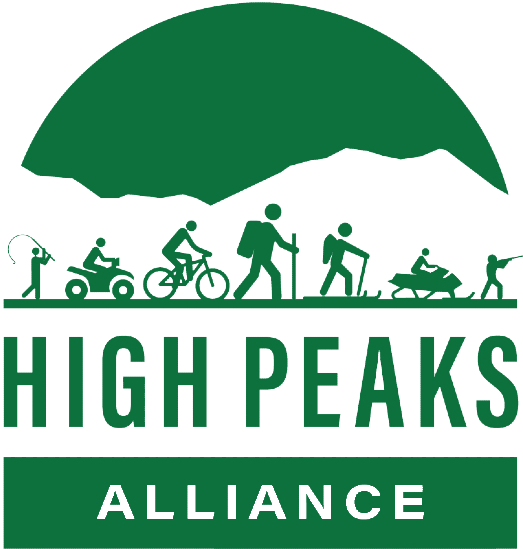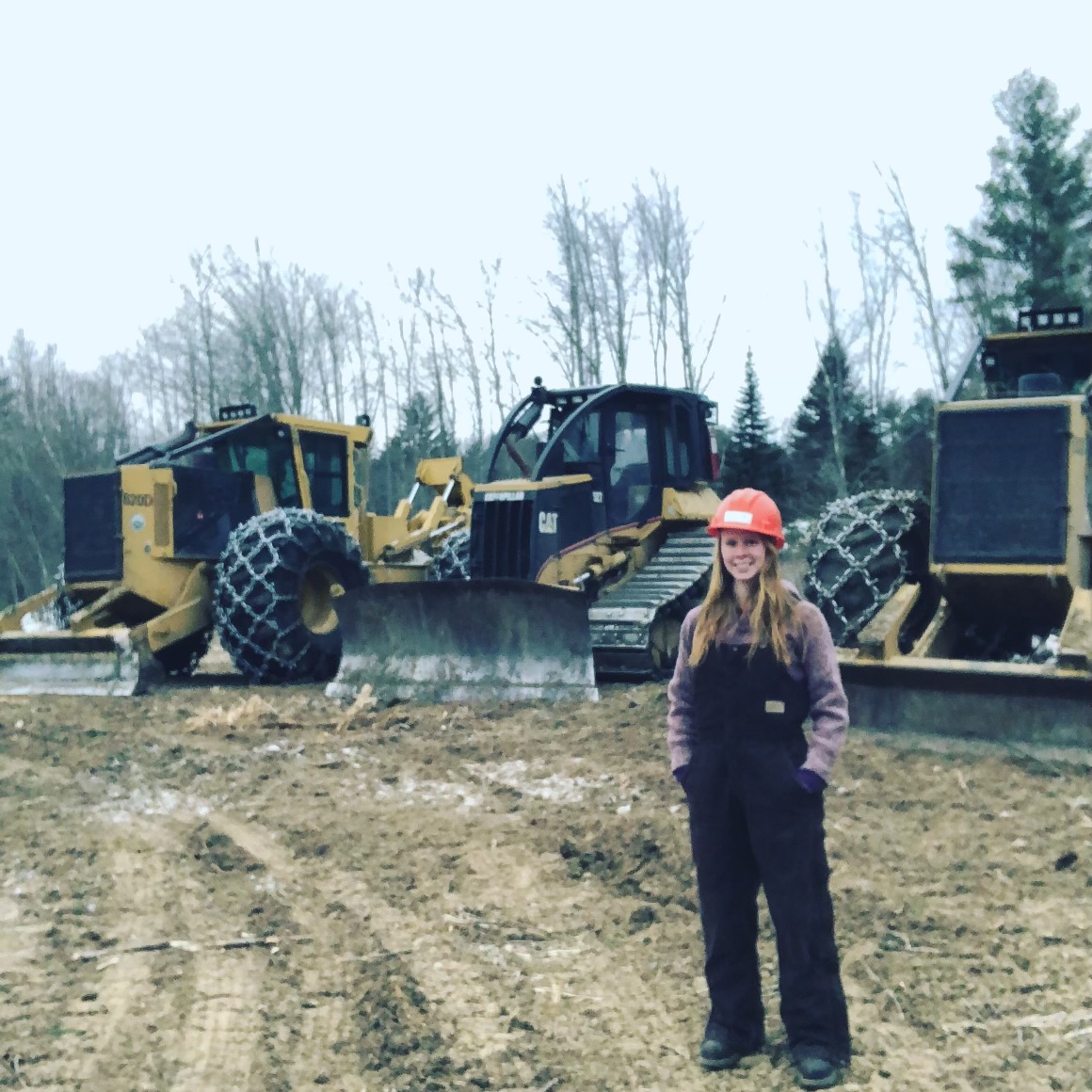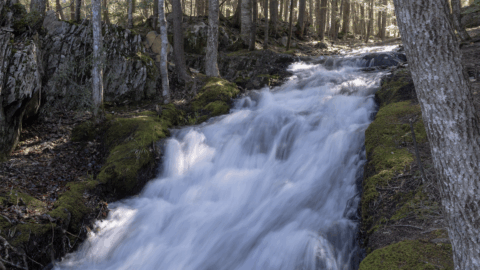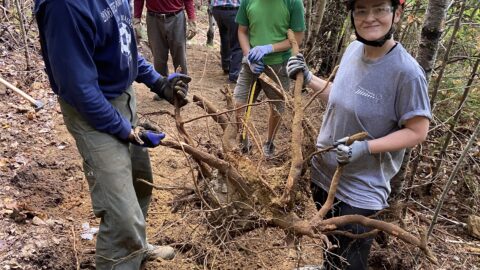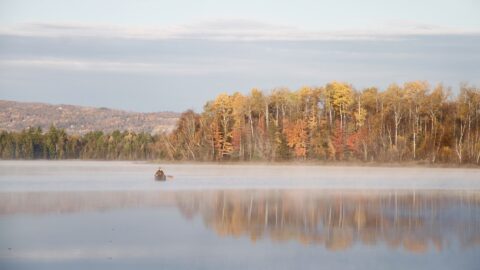Welcome to the latest installment of the Voices of the High Peaks Series, where we explore the rich tapestry of experiences and perspectives that shape our region. Today, we’re delighted to present an insightful interview with Julie Davenport, a second-generation forester and District Forester with the Maine Forest Service.
In this interview, Julie shares her passion for educating the public about forest health, dispels common myths about tree cutting, and highlights the importance of active forest management. She also provides valuable insights into the resources available to landowners and her vision for fostering a deeper connection between people and the forests that surround them.
To that end, we’re excited to announce that the High Peaks Alliance will be co-hosting three Tree Identification Walks this summer with Julie at Shiloh Pond, Perham Stream Birding Trail, and the Saddleback Spur of the Fly Rod Crosby Trail. Details at the bottom.
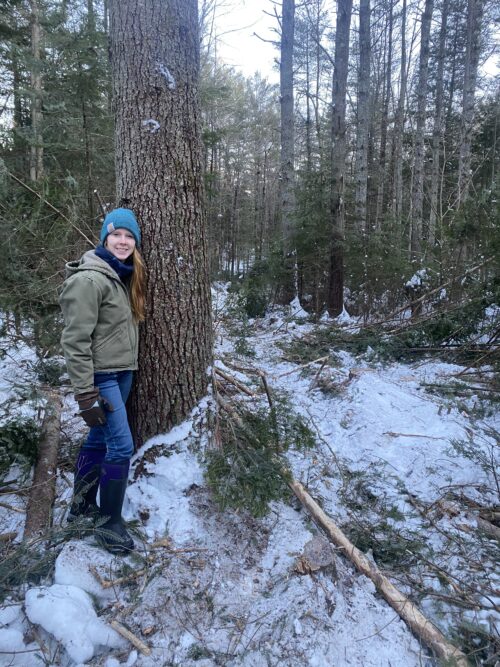
Get to Know Your District Forester
How did you come to be a forester?
I grew up with my dad working as a consulting forester, though I’ll admit I didn’t fully understand what he did at the time. I knew he worked in the woods every day and seemed genuinely happy. When I was in high school and deciding on a career, I thought, “Well, my dad’s happy and gets to be outside—forestry sounds good.” So, I went to the University of Maine to study forestry. It turned out to be the best-uninformed decision I’ve ever made. Not only do I enjoy the work, but there’s plenty of it available. It was a leap of faith that worked out wonderfully. I’m currently a District Forester with the Maine Forest Service.
What do District Foresters do?
My role involves serving as a resource for anyone interacting with Maine’s forests. This includes walking properties with landowners to help them understand their forest and how it can meet their objectives, working with loggers to clarify timber harvesting regulations, and conducting programming in schools. However, as part of my role, I cannot perform tasks that private foresters are paid for, such as writing management plans or overseeing timber harvests. This policy ensures my recommendations remain unbiased since I have nothing to gain or lose from what landowners choose to do with their property.
90 Communities, 1 Forester
Your district spans both Franklin and western Kennebec counties. Could you paint a picture of the forests, landowners, and common land uses you find in each of those areas?
I probably have one of the more diverse spreads or districts of most folks that I work with. I have all of Franklin County, and then I have the western half of Kennebec County, basically for the most part, west of the Kennebec River.
Those two areas are very different both land-wise and forest-wise, but also the way people think of and utilize their forests seem a little bit different as well. There’s not one that’s better than the other, they’re just a little bit different.
The more western and northern areas seem to be bigger parcels. The people who do live there year-round are very involved with their forests, and then there’s a lot of people who own fairly big chunks that live out of state but are excited to come to their land and walk around with me. Even though they don’t live there they’re passionate about the area.
The Kennebec County areas of my work region are kind of a good mix of seasonal versus year-round people.
I have 90 towns in my district so it’s a pretty big chunk of the state. I always joke that if you ask any district forester who has the best district, they’ll tell you it’s their own district. I’m no exception – I firmly believe that I have the best district in the state.
Do you have a favorite spot in the High Peaks region?
Choosing just one spot is challenging because there are so many great places. My general answer is that I love the Bigelow Range; I could never get tired of hiking there. I enjoy looking out over Flagstaff Lake from the top or even just seeing it from Route 27.
If I had to pinpoint a specific spot, I like Reed Brook Falls in Kingfield. It’s very accessible and offers a high reward. I like recommending it to people who are new to the area, and I’ve had great experiences taking my kids there. While the Bigelows are my grand favorite, Reed Brook Falls is more accessible.

Partnerships at Work
How has partnering with the High Peaks Alliance helped you expand your network in the region?
When I look at the distribution of work that I’m doing, the more I can get up north, the more I want to. I started 2025 thinking about how I could get more involvement and engagement in the northern parts of my district, and that was part of why I reached out to the High Peaks Alliance. That worked out great because you helped me make connections with some other new partners in the area that I might not have known to reach out to on my own. That’s been my goal for the year. I want to get more involved and active in not just Franklin County in general, but especially the northern parts.
Are there challenges that landowners are facing that they share with you?
I would say the challenges are fairly similar across the region. Many of the things that people struggle with are the same over and over. For example, less-than-ideal wood markets sometimes make good forest management challenging. The balancing act of trying to manage a single piece of land to meet a lot of different objectives can sometimes be a challenge, too.
I’ve noticed that in-town and in more southern areas where I work one of the biggest issues is invasive plants. The farther north and west I go, the less of a concern that seems to be. I hope that that stays that way for a long time.

Timber Harvesting is like Surgery
What tools do you utilize to get people without a forestry background to understand forestry management?
The woods walk is the best tool that I have, and that’s great because the most fun part of my job is when I get to walk with someone on their property. People tend to learn better in real life. It’s so much better when I can point at two different trees and say those trees are growing the way that they are because of XYZ. To sit on a webinar or to read something is just not as effective as when you can look at something in the real world and see real examples of how things change over time.
It’s like the forest or the inhabitants of the forest play right into what I’m trying to say sometimes. A bird will fly out of a snag tree just as I’m telling people how great those are for wildlife.
Is there a forestry myth that you would like to shine a light on?
I constantly hear about boundary line trees. People will say, “Oh, you can harvest every other one”. That is not true. That’s not true at all. I would love for that to go away. Both landowners own an equal interest in every single tree on a boundary line. Unless you have explicit permission from your neighbor, you can remove that tree, please don’t cut it down.
How do you address the concerns of people who are hesitant about cutting trees?
The notion that cutting trees is always bad for the forest is a myth. A well-managed forest is a healthy forest. Much like a garden, if you’re trying to grow carrots and you’re not taking out every other one, you’re going to end up with an entire crop of spindly, unhealthy carrots.
The garden you’re growing them in can only support so many. When they’re grown too tightly, they’re not vigorous and they’re more prone to pest or disease outbreaks. Forests are the same way.
My favorite analogy to make is that forest management, especially timber harvesting, is a lot like surgery. You would be choosy about who you work with and who you’d allow to cut into your body. Usually, if you’re having surgery, there’s a reason for it. It looks kind of messy and scary, not only while it’s happening, but immediately afterwards, and it takes a little while to heal. But usually, if you’ve done everything right, in the long term, it does a lot of benefit, and if you’ve done it for a good reason, you’re healthier as a result.
Connect with Julie
Are there any Forest Service resources that you would like people to know more about or utilize more?
This is the part where I’m going to plug myself. Everyone in the state of Maine who owns forestland is eligible for a free on-site visit from a Maine Forest Service District Forester. A lot of people don’t realize that. We all love to get out and walk with people and talk with people, so I wish more people realized that we’re here. I’m always surprised by the number of people I meet who say they didn’t even know this service existed.
Your district forester is kind of like your one-stop shop or your first place to go. We can do a woodland walk. We can connect you with resources for any topic that you’re particularly interested in that relates to trees or forests. We all maintain up-to-date and accurate lists of foresters that are available for hire in our work area. If you’re looking to plan a timber harvest or you need a management plan update, those are all things we can help connect you with someone for.
There are different cost-sharing programs available. For a long time, there has been a Woodland Resource Action Plan program. Essentially, you can get a management plan written and prepared by a licensed forester, and then, through federal funding that’s managed through the Maine Forest Service, you can get reimbursed for part of the cost of that plan.
Is there anything you would like to share with landowners?
You can do a lot of things with one property. If you’re managing based on your landowning objectives, you can grow timber and manage for wildlife and have recreation all in one forest. It’s not all or nothing.
Another thing I like to remind people is that, from a diversity standpoint, you don’t have to do it all on just your property. Think bigger than your ownership. If you have 40 acres but it’s all middle-aged, northern hardwoods, and your neighbor to the north recently made a clear cut so she had 20 acres of young regenerating birch and poplar, and your neighbor to the south has an untouched forest of cathedral hemlocks, you’re already maximizing diversity in your neighborhood at the landscape level.
If you’re a landowner in Franklin County or western Kennebec County, don’t hesitate to connect with Julie directly. Her wealth of knowledge and free on-site visits are invaluable resources for anyone looking to better understand and manage their woodland property. You can reach Julie by phone at 207-592-2238 or via email at [email protected]. There are also ways to get in touch with the Maine Forest Service as a whole, and that’s [email protected]. The general Maine Forest Service number is 207-287-2791.
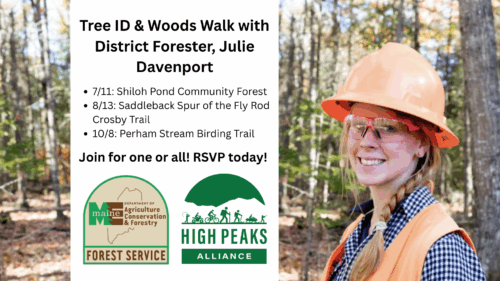
Tree ID Series with Julie
Event details:
- June 11, 2025: Shiloh Pond Community Forest (Kingfield)
- August 13, 2025: Saddleback Spur of the Fly Rod Crosby Trail (Dallas Plantation)
- October 8, 2025: Perham Stream Birding Trail (East Madrid)
These walks are perfect for nature enthusiasts, landowners, and families looking to deepen their connection to the forest. Participants will gain valuable skills in tree identification, learn about the benefits of active forest management, and discover resources available for landowners through the Maine Forest Service.
The events are free, but space is limited! For more information, contact Julie at [email protected].
